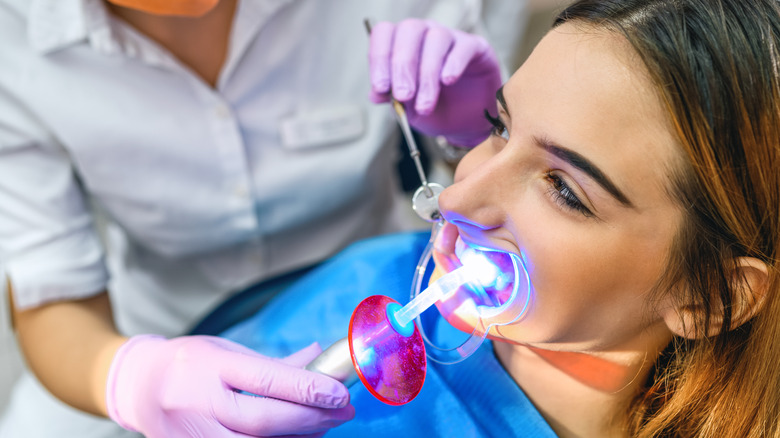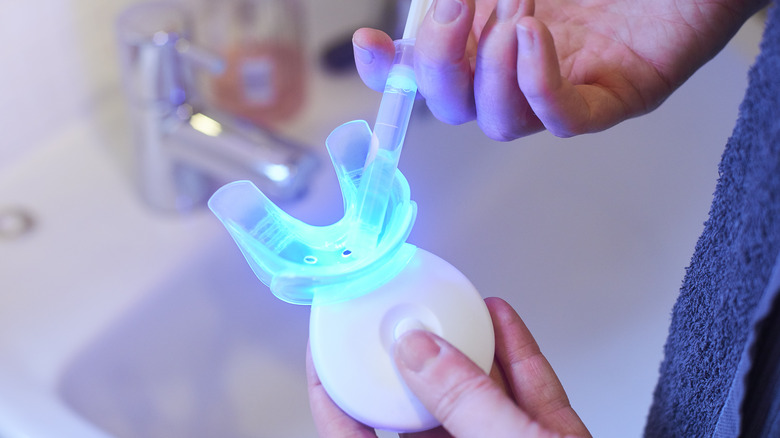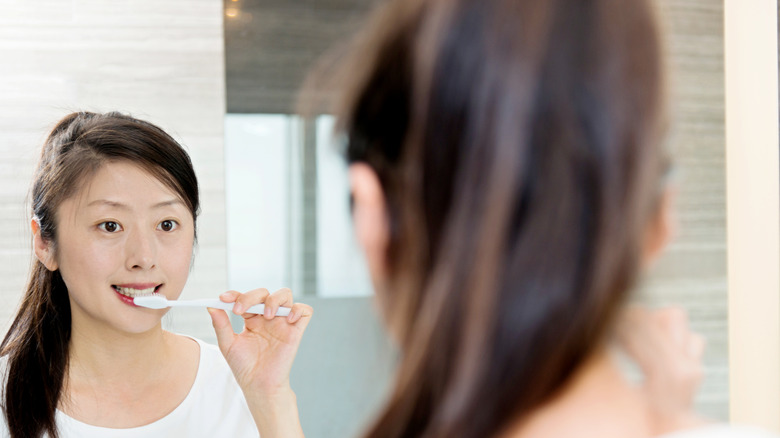Is LED Light An Effective Form Of Teeth Whitening Or Just Another Internet Conspiracy?
Over the years, we've seen our fair share of teeth-whitening gimmicks — everything from bleaching gels to disposable strips has promised us shinier, whiter smiles. Now, LED light is growing in popularity as a solution for those who want sparkling teeth without the hassle of using products like sticky whitening strips. However, skepticism around the effectiveness of LED light for teeth whitening is beginning to rise.
Since this form of teeth whitening debuted on the scene, studies have been carried out to evaluate whether LED light can have a noticeable impact on the color of teeth. A 2016 study published in the Journal of Conservative Dentistry examined how light and laser activation could enhance stain removal during bleaching. While researchers saw slightly more whitening when lights and lasers were used, they didn't consider it statistically significant. A 2012 study published in The Open Dentistry Journal specifically looked at how LED light could potentially whiten teeth as well, and researchers considered the noticeable change in color to be "relatively low."
While this form of teeth whitening isn't exactly an internet conspiracy, it's important to know you may not see bright white results upon investing in this cosmetic treatment. However, there are still ways you can help your smile shine, and they don't involve the use of LED lights or other trendy procedures.
How LED light supposedly helps whiten teeth
If you choose to go through with LED light teeth whitening, despite the potential for lackluster results, the procedure itself is relatively simple. Upon making the appointment with a dental professional, you'll have your teeth cleaned once you arrive before a whitener is applied to them. The dentist will then likely use tools designed to keep your mouth open and protected during the whitening. Once the whitening gel is on your teeth, the LED light is used to speed up the stain-removal process.
The idea behind using the gel is that its active ingredient — hydrogen peroxide — can be absorbed by the layers of the teeth. While some over-the-counter whitening products also include hydrogen peroxide, professional whitening gels often have a higher concentration to provide quicker, more noticeable results. This ingredient is also critical to helping break down and dissolve stains.
LED lights were added to the process when some experts began to believe they could speed up the whitening process even further. However, there is a lack of evidence pointing to LED light as reliable a whitening solution. Furthermore, some research indicates that LED light teeth whitening can result in tooth and gum sensitivity after the procedure, according to WebMD. For this reason, it's important to discuss both the risks and benefits with your dentist before undergoing this treatment to see if it's right for you.
How to avoid staining your teeth in the future
While we would all love to have a sparkling, white smile that requires no maintenance, dental hygiene is something we have to take seriously if we want our teeth to last as long as possible. Depending on how you choose to whiten your teeth, you may run the risk of side effects. For example, frequent teeth bleaching can lead to tooth and gum sensitivity, demineralization, and even tooth and gum damage (via WebMD). Given that whitening procedures, including LED light whitening, often provide short-term effects and unsatisfactory results, you might want to focus on how to keep your teeth white in the future instead.
Brushing your teeth twice a day is the most obvious way to keep them clean and bright. Make sure to brush for two minutes each time, and try to use a toothbrush with soft bristles. Aside from regular brushing and flossing, it's important to maintain regular cleanings and dental appointments as well. Limiting your consumption of food and drinks that are more likely to stain your teeth, such as coffee, red wine, and berries, can help you keep your teeth white. (We know — your coffee habit is sacred, but indulging in it can be approached with caution.)
If you've tried over-the-counter whitening products and you're unsatisfied with the results, talk to your dentist about alternative solutions. They can also provide you with insight into why you may be experiencing tooth discoloration and offer prevention tips for the future. After all, keeping your teeth clean and healthy is paramount.


